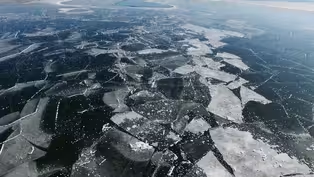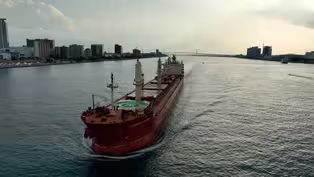
Isle Royale
Clip: Season 3 Episode 10 | 9m 40sVideo has Closed Captions
Visit a remote island where wolves and moose have been studied for more than 60 years.
Monitoring moose and wolves on the least visited National Park in North America. For more than 50 years, researchers have been closely watching the predator-prey dynamic going on between moose and wolves on Isle Royale National Park. Great Lakes Now travels to the island to meet the lead researcher and find out what he’s learned about these creatures.
Problems playing video? | Closed Captioning Feedback
Problems playing video? | Closed Captioning Feedback
Great Lakes Now is a local public television program presented by Detroit PBS

Isle Royale
Clip: Season 3 Episode 10 | 9m 40sVideo has Closed Captions
Monitoring moose and wolves on the least visited National Park in North America. For more than 50 years, researchers have been closely watching the predator-prey dynamic going on between moose and wolves on Isle Royale National Park. Great Lakes Now travels to the island to meet the lead researcher and find out what he’s learned about these creatures.
Problems playing video? | Closed Captioning Feedback
How to Watch Great Lakes Now
Great Lakes Now is available to stream on pbs.org and the free PBS App, available on iPhone, Apple TV, Android TV, Android smartphones, Amazon Fire TV, Amazon Fire Tablet, Roku, Samsung Smart TV, and Vizio.
Providing Support for PBS.org
Learn Moreabout PBS online sponsorshipFor more than 60 years, a team of researchers has kept a close eye on a remote island in Lake Superior, studying the moose and wolves who live there.
Great Lakes Now correspondent Ian Solomon traveled to Isle Royale National Park to experience it firsthand.
- Let me tell you guys I am up super early to catch the Isle Royale Queen IV.
The ferry will be departing at 8:00 AM sharp to carry us out to the island.
First, I load my massive backpack onto the boat and then I make a beeline for the cafe.
Thank you, you too.
Got it.
I need to fuel up with a breakfast sandwich and of course coffee for the long journey.
We leave the dock in Copper Harbor, Michigan at the northernmost tip of the Keweenaw Peninsula which juts way out into Lake Superior.
It takes almost four hours by boat to get to Isle Royale, the country's at least visited National Park because of its remote location.
The island is actually surrounded by 450 smaller islands with a total area of 850 square miles.
During the ferry ride to the island I can't stop taking photos and videos.
All around me is this amazing natural beauty.
The boat pulls up to the dock and I immediately get to work setting up my tent.
I'm here at Isle Royale, just got off a nearly four hour ferry ride.
But guys, I am so excited to be here.
I mean, we got my tent set up here with a nice water view over this ridge and honestly, I just can't get over how ancient this place feels.
I mean, the trees are huge.
You have berries everywhere.
There are wild flowers just springing up from every point they can.
It feels incredibly untouched and I just cannot wait to explore.
I've reviewed my maps and it's time to finally hit the trail.
Isle Royale is known for its population of moose and wolves.
I don't know if I want to come face to face with a wolf but I definitely want to see a moose.
I stop several times to take photos of all the plants and trees and just soak it all up.
I've come here to learn everything I can about the unique ecosystem.
Isle Royale received an International Biosphere Reserve designation in 1980 and I can see why.
- Did you see the moose droppings, Aaron?
Normally droppings aren't really my thing, but that's how bad I want to see a moose.
And then not too far into our hike, it happens.
So you can see the moose right through this brush right here.
It has two babies, so we're being careful to not get too close because moose will charge if they feel like their babies are threatened.
But I'm amazed right now, like I'm losing my ...ish!
So far I can say this.
Isle Royale does not disappoint.
(bright music) It's day two.
After spending the night in my cozy little tent I head over to a place called Bangsund Cabin.
I've come here to meet Rolf Peterson and his wife Candy.
For more than 50 years they've spent their summers here studying wolves and moose.
- Looks like a different kind of device.
What's that?
- Polaroid?
Yeah, threw it all the way back, right?
- That's way back.
- So you need a place, a dry place to put something down?
- Rolf is a research professor at Michigan Tech University.
He's the lead researcher on the long running Wolf-Moose Project which is studying the predator prey interaction between moose and wolves.
So I just wanted to, you know get an understanding of where did this study begin and why.
- Oh it began in the mid 20th century, the darkest period for wolves in North America, worldwide actually.
After several years of lead up to try to figure out in a place where people weren't killing wolves what do wolves really do in nature?
That's the simple start and that's still what we're doing.
- And so what are some of the methods of data collection?
What is the process like?
- Well, our main objectives for science each year are how many wolves are there, how many moose are there and how many moose are the wolves killing?
So what's their predatory effect?
And that's done primarily from aircraft in the winter, light aircraft.
- New scientific tools have been game changers.
GPS allows Rolf's team to pinpoint the exact locations of moose and wolves.
And a DNA analysis revealed serious inbreeding in the island's wolf population.
- And there were some serious problems in their spine.
Every wolf had spinal defects, extra vertebrae, asymmetrical vertebrae, things that would cause problems if it was your dog, pain, inability to move appropriately.
- The population needed new blood literally.
But the park service had a dilemma.
Should they bring in new wolves to help the wolf population recover?
Or should they let nature take its course and keep the research pure?
Eventually in 2018, the decision was made and 19 wolves were brought in from the mainland and released on Isle Royale.
I was snooping around a little bit, sorry.
And I noticed this.
Another amazing array of bones and more specifically bones with these huge antlers on them.
- Oh yeah.
- Near Rolf's cabin is an amazing collection of moose bones.
For him, it's a treasure trove of information.
In collecting these skulls and moose, you know, what are you looking for?
What is, where's the information points coming from?
- Oh, well, we get basic demographics, age and sex of each moose.
The sex comes from, you know the bulls have antler pedestals, bases.
The age comes from pulling a tooth and counting cementum lines, cementum annulations in the teeth, in the roots.
And then beyond that we're looking for any indicator of health.
- Could you show me if there are any like health indications on any of these skulls?
- Oh, you bet.
There's three big pathologies that we see in moose.
One is osteoporosis, which is indicated by these lesions, these thinning areas.
- Moose also develop periodontal disease, that's gum disease.
- Just like we do in people, gum disease, not because they don't brush their teeth 'cause they never brush their teeth.
- Finally also like humans, moose can develop arthritis but for a moose on Isle Royale, that's a major problem.
- This is a death sentence if you're living with wolves.
Wolves can detect any kind of an abnormality in moose and they're looking for abnormalities which make them more vulnerable to predation.
- The average lifespan of a moose on Isle Royale is about 10 years.
And for wolves it's only about four and a half years.
- (whispers) Unreal.
- I want people who come to Isle Royale to leave with their faith in humanity restored.
- Rolf's wife Candy has also been studying wolves and moose for decades, but with a more philosophical viewpoint about nature and the role that humans play.
- What I hope people realize is when you hear that phrase let nature take its course.
Don't write people out of nature.
We are needed as never before.
- Candy says humans need to learn from their mistakes and then get to work fixing the problems we've created.
- We are a caring animal.
We care about other species.
We are amazing.
We just haven't lived up to our potential because we've bought into the part of us that's also greedy and selfish and frightened.
So we have to overcome that.
The healing nature of nature, it's in us all and we need to trust it and work with it and bring it out of one another.
- They're not suffering too long though.
Thank you.
We say our goodbyes to Candy and Rolf and then hop on our little boat to explore some of the other surrounding islands.
(bright music) Oh my God, there's a lighthouse.
This is crazy!
And as we're headed back to Rock Harbor to catch the ferry to the mainland, we see this.
That's an actual moose in the water.
I mean, this is our now third moose sighting.
I'm speechless like, and it's a moose swimming.
I've never, I didn't even know moose could swim before coming here, so I'm just so grateful.
This has been amazing.
It has been a Moose-full trip!
From its incredible wildlife to its incredibly knowledgeable and passionate people, I understand why they say Isle Royale is the least visited, most revisited National Park.
Video has Closed Captions
Clip: S3 Ep10 | 2m 57s | The Catch is GLN’s one stop shop for bite-sized news and events about the lakes you love. (2m 57s)
Video has Closed Captions
Clip: S3 Ep10 | 8m 1s | Freighter pilots are helping to keep Great Lakes waterways, and other boaters, safe. (8m 1s)
Providing Support for PBS.org
Learn Moreabout PBS online sponsorship
- Science and Nature

Explore scientific discoveries on television's most acclaimed science documentary series.

- Science and Nature

Follow lions, leopards and cheetahs day and night In Botswana’s wild Okavango Delta.












Support for PBS provided by:
Great Lakes Now is a local public television program presented by Detroit PBS

